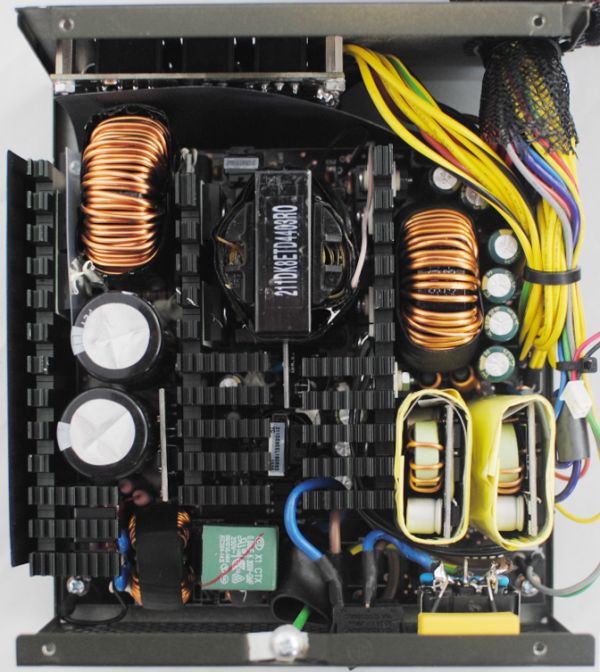In Win Commander II 1200W
by Martin Kaffei on June 10, 2011 1:10 PM EST- Posted in
- Cases/Cooling/PSUs
- PSUs
- 1200W
- In-Win
Internal Design
Cracking open the case, we can see an Andyson design with DC-to-DC VRM, three large heatsinks, and not much space between the components for airflow. The EMI filtering consists of four Y caps, two X caps, and some chokes. Since the PCB was too short, Andyson chose to glue some Y caps in the air and connected them with small cables. There is no MOV and the solder point for the Thermistor is bridged. Most cables have shrink tubing.
The main caps are two Panasonic HC with 400V. They are rated at 105°C (2000h endurance), which is unremarkable. The capacitors in the secondary circuit are from Teapo (SC series). The shielded DC-to-DC modules on the bottom right use all solid capacitors. The main MOFETs are two 24N60C3 in a very big housing, which is good for the thermal resistance. This PSU has SR (synchronous or active rectifying) with some IRFB3206 transistors that have excellent characteristics for this kind of application. In the bottom right, there's a very large safety IC. The PS232S supports OCP for six rails (+3.3V, +5V and the four +12V rails). Overall In Win has chosen a densely packed layout with modern technology.

















18 Comments
View All Comments
ckryan - Friday, June 10, 2011 - link
There is a lot of focus on the 1000w+ category of power supplies, but how big could the market really be? Outside of the tri-and quad SLI/Crossfire market, there just isn't much need for these. I guess I'm glad they're there, but I wish there was more a focus on making higher quality, lower powered units. The good news is that it looks as though some of the newer higher end PSUs will be efficient at all loads -- which is good, since even Seasonic is headed towards more and more powerful units even as system power draw levels are trending down with the advent of Sandy Bridge.MrTeal - Friday, June 10, 2011 - link
I agree, I'd much rather see a full review of the be quiet! supplies that we mentioned a few days ago than the continual reviews 800-1200W supplies. I'd love to see a thorough review of a high quality 300W supply.Martin Kaffei - Friday, June 10, 2011 - link
http://www.anandtech.com/show/4069/huntkey-300w-80...And as already mentioned in the text we had some smaller PSUs before.
http://www.anandtech.com/show/4343/antec-hcg-520-g...
ckryan - Saturday, June 11, 2011 - link
Martin,I hope you review every PSU you can possibly get your hands on. I don't have a problem with 1000w+ PSUs, and if I needed one, I'd buy two. If a PSU could be just as efficient at 4% or 5% loads as at 20% or 50% loads, I'd be using a kW unit too. At least this unit gets >80% at 10% loads. I'm guessing it's the most profitable slice of the PSU pie, a brand prestige product as well. Undoubtedly, more attention to quality is usually given to these big units.
I've already have lamented in the past that my last PSU purchase was for a 650w unit -- a good all around unit but still way overpowered. At least when my computer idles at 56w (at the wall), my PSU is still pretty efficient. The huntkey jumper still isn't here in America, and the closest competitor is the FSP Aurum 400w, which is either really popular or hard to find since it's been out of stock at the Egg for quite some time. So I know some people want to see more 300w - 500w quality units -- at least some manufacturers have decided to go in that direction too -- now, they just need to get them to North America and to AnandTech's fortress of PSU reviews.
A5 - Friday, June 10, 2011 - link
They can only review what PSU makers send them, and these are the units they get sent since they make the PSU makers the most money.esSJae - Friday, June 10, 2011 - link
Maybe 5 1000W+ reviews in the last year is a lot of focus?I thought this was supposed to be an enthusiast's site?
brucek2 - Friday, June 10, 2011 - link
Thanks for an excellent review. Specifically, I love that:1) you provided details on what is inside the box and the quality/impact of each component
2) the review is clearly aimed directly at the readers (hardware enthusiasts), vs. trying to strike some sort of diplomatic balance between readers and marketers (note the absence of marketing fluff and willingness to call the product out on its weaknesses).
3) the conclusion provides a comparison to other options in the market with specific strengths/weaknesses of each called out.
I'm getting so spoiled here that I'm finding it increasingly hard to read "reviews" in the mainstream press. For instance, I just read a few reviews of A/V components that didn't even bother to tell you what chips were on the board. Maybe there's an opening for AnandTech to expand into?
amf66 - Friday, June 10, 2011 - link
I really enjoyed reading this review. It did a good job of explaining the weaknesses of the connector choices and I doubt many others would have noticed the 10A power cable for a PSU that pull more than this. I always like seeing the internals of power supplies and having the components explained and this did a great job at that. The only small problem is the typo in the first paragraph of the last page. Other than that it was great.Martin Kaffei - Friday, June 10, 2011 - link
Thanks for the correction, "definetly " helpful.krumme - Friday, June 10, 2011 - link
For ryans Intel SB+gtx 590 vs. Llano Review